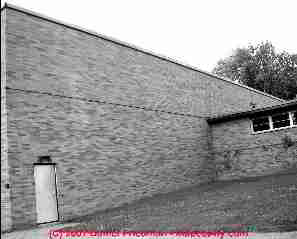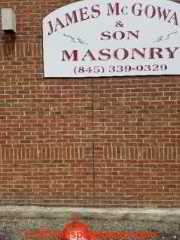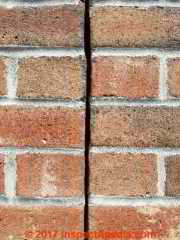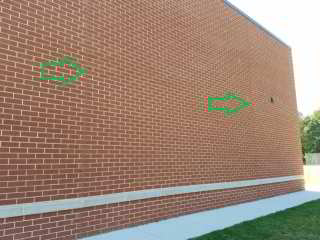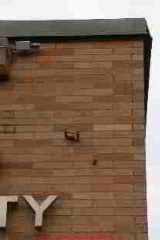 Thermal Expansion Cracks in Brick Walls & Foundations
Thermal Expansion Cracks in Brick Walls & Foundations
- POST a QUESTION or COMMENT about brick wall or foundation cracking caused by theraml expansion
Brick wall cracking due to thermal expansion:
We illustrate properly-designed control joints to prevent cracking in brick walls.
This article series describes ypes of concrete and other masonry wall & foundation cracks, crack patterns, differences in the meaning of cracks in different foundation materials, site conditions, building history, and other evidence of building movement and damage.
This information assists in recognizing foundation defects and helps separate cosmetic or low-risk conditions from those likely to be important, possibly quite dangerous, and potentially costly to repair.
InspectAPedia tolerates no conflicts of interest. We have no relationship with advertisers, products, or services discussed at this website.
- Daniel Friedman, Publisher/Editor/Author - See WHO ARE WE?
How to Identify, Diagnose, & Evaluate Thermal Expansion Damage to Brick Walls
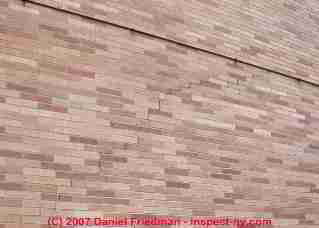 This article describes extensive damage that can be caused to brick structures due to thermal expansion of long brick walls lacking expansion joints.
This article describes extensive damage that can be caused to brick structures due to thermal expansion of long brick walls lacking expansion joints.
We list factors that determine the extent of thermal expansion damage to a brick wall or structure. Absence of control joints or expansion joints in long brick walls leads to extensive cracking damage, and we provide photographs of brick wall crack damage attributible to thermal expansion
We describe how to recognize, diagnose, & evaluate thermal expansion cracks in brick walls &: brick foundations and how to distinguish between this type of cracking failures and other cracks and movement in masonry foundations or walls, such as concrete, masonry block, brick, stone foundation damage due to impact, settlement, frost or water damage, and other causes.
Thermal expansion failures in structural or veneer brick walls:
is a topic misunderstood by many builders, masons, engineers, architects, and inspectors.
As Dave Wickersheimer, R.A. P.E. and masonry failure expert has pointed out, brick "grows" in size indefinitely [though probably most of its size increase is early after it's manufacture.]
But a separate factor that can cause very large movements and extensive damage to brick structures or brick veneer walls is the thermal expansion which occurs across a long or tall brick wall when that wall is heated by sun exposure.
The photographs here show significant thermal expansion damage in a long brick structure - the Poughkeepsie NY Jewish Community Center) when we first photographed it in 1989. We visited this site again for an update in June 2007.
This brick veneer wall was built over a concrete block building.
The brick veneer was attached using normal steel strap methods and the brick veneer was also reinforced at intervals using a horizontal steel wire. But the wall, more than 100' long, was built without a single expansion joint.
As the south-facing wall of this building heated in summer sun the wall grew in length until it pushed out the East and West building corners at their tops for a total of nearly 3" measured by dropping a plumb line from each building corner.
The veneer movement produced a variety of damage, including:
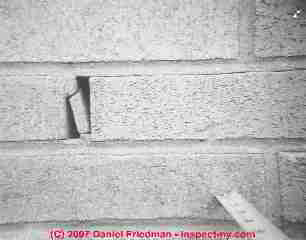
- Significant breaks and gaps
at vertical brick mortar joints due to thermal expansion and perhaps some frost and water damage are shown in our photo above.
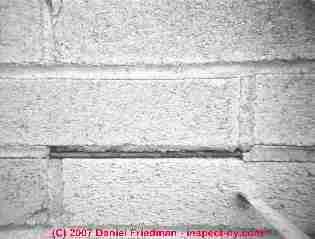
- Horizontal sliding breaks
in brick mortar joints [above], exposing reinforcing wire to rust, exfoliation, and additional damage from those forces as the exfoliating wire produced still more pressure on the mortar joint.
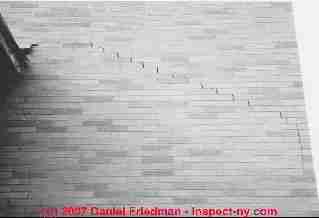
- Step cracking
following mortar joints near the building corners and where the wall movement was resisted by first story intersecting brick walls abutting at right angles the middle section of the long brick wall. This long brick wall was built with no control joints.
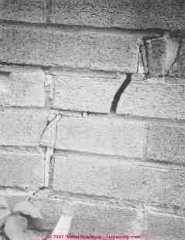
- Cracks and broken bricks, and damaged windows
at intersections of brick walls and these openings. Additional window damage is shown in the color photograph lower on this page. - Cracks in the interior concrete block structural wall
were observed in the building interior - Leaks and water entry and some frost damage and related loosening of the brick veneer
at various locations around the building but were most severe in areas exposed to thermal expansion of long brick veneer walls.
We were surprised that there was not more extensive damage to the structural walls themselves, and we urged the building management to consult an experienced mason for further inspection and repair. We expected the mason to cut vertical expansion joints in the wall and to seal these joints with an appropriate flexible filler material or gasket.
No repairs were made, the cracks had grown slightly, and leaks had increased at the time of an informal site inspection and visit we made again in June 2007, as shown in the photographs below.
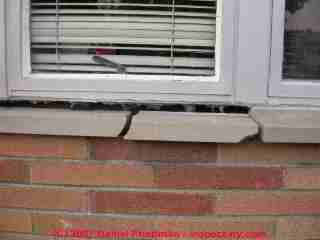
Factors which determine the extent of thermal expansion damage to a brick wall or structure
Above: an open a control joint built into a brick wall of a building in Kingston, NY. It's no surprise that this wall had a good control joint in the brick wall: note that the sign indicates that this building houses James McGowan and sons, a Kingston masonry company.
Below: sealed control joints in a brick veneer at the Van Scriver Elementary School in Haddonfield New Jersey. These control joints are placed at intervals of 25 stretcher brick courses - green arrows.
- Proper installation of thermal expansion joints
is the critical design factor to avoid thermal expansion damage to brick.
Omission of the expansion joint in a long brick wall is likely to lead to cracking damage, particularly on long walls.
[See our photos above] [Click to enlarge any image] - Selection and application of connectors
between the brick veneer and the structure is an important factor - some connectors permit more movement between the brick veneer and the structure.
However even if a large brick veneer wall is properly fastened, if lacks expansion joints damage is likely, especially on the sun-exposed walls - Sun exposure:
simply walking around a large structure such as the building complex shown in these photographs, it becomes quite apparent that thermal expansion damage occurs worst on long brick walls which are facing South and/or those which receive the most sun exposure. - Means of brick veneer attachment:
A second factor in the probability of damage to a brick veneer wall is the means of attachment of the veneer to the building structure.
Brick veneer walls were traditionally secured to the underlying wood or masonry structure using corrugated steel strips which were fastened at one end to the structure and at the other end laid in the brick veneer wall at mortar joints.
These connectors permit some vertical movement between the structures but resists lateral movement. Some newer brick veneer connectors are designed to permit horizontal as well as some vertical movement differences between the brick veneer wall and the structure.
And of course, where proper expansion joints are provided in the expanse of a brick wall and at windows and doors which penetrate that wall, we should not see thermal expansion damage to the bricks nor to the structure.
Below, a closer look at the sealed control joints at the control joints in a brick veneer at the Van Scriver Elementary School in Haddonfield New Jersey.
- Brick veneer bottom support:
on some residential properties we've found loose brick veneer walls that lacked adequate support to carry their weight.
Typical brick veneer support on a residential building uses either a steel angle iron fastened to the foundation wall to carry the bricks from their first course, or if the brick veneer was in the original plans for the building the architect or builder may have specified that the building foundation wall project approximately 4" (one brick width) out from the building structural wall to carry the load of the bricks. - Combined effects of weather & thermal cracking
may increase cracking and movement in a brick structure or brick veneer structure.
It's possible that the wall-corner cracks in the photograph at the top of this page were aggravated by leaks at the roof or roof parapet since this building is located in a freezing climate. - Distinguishing between brick thermal cracking and frost cracking:
How can we distinguish between brick cracking due to roof or parapet wall leaks and brick cracking due to thermal movement: a leak and frost related crack on a masonry building tends to be horizontal near the top of the building wall at about the location of the roof surface behind the parapet wall, or just below that point - describing where water is entering the structure.
Thermal cracking in the same brick wall will generate stair-step cracks or vertical cracks near the wall ends (or building corners) and will be independent of high-on-wall horizontal cracks that map the surface of the roof itself. - Brick veneer vs. structural brick:
OPINION: we suspect that at least in some cases, a brick veneer wall might suffer worse damage from thermal expansion than a brick structural wall, based on the hypothesis that a brick veneer wall, being a single brick in thickness, has less thermal mass and so will heat up more quickly across its surface than a structural brick wall which will be two or more wythes of bricks in thickness, joined by bond courses. - Cracks & Movement in Loose Brick Veneer Walls - Support Issues?
See BRICK VENEER WALL LOOSE, BULGED for details of bulged cracked brick veneer wall damage caused by inadequate support, frost, or building damage - low-rise residential buildings.
...
Reader Comments, Questions & Answers About The Article Above
Below you will find questions and answers previously posted on this page at its page bottom reader comment box.
Reader Q&A - also see RECOMMENDED ARTICLES & FAQs
On 2020-07-21 by Daniel
If you are looking for a reliable and experienced masonry contractor in Boston head over to AMN masonry, they offer wide range of services including, brick and stone repointing, concrete repair, and historic building restoration services as well.
On 2019-08-05 - by (mod) -
If you can cut the old sealant sides sufficient to pry it out of the expansion joint using a simple utility knife or in combination with a putty knife that would be a start but I wouldn't remove it until you're ready to install the new sealant.
It's also important that the expansion joint surfaces be clean and dry
On 2019-08-05 - by (mod) -
Thanks for the added detail for the question. Since the expansion joint goes all the way through the brick a baccarat it's not a bad idea.
I need to do some research to make some specific suggestions on expansion joint sealant products used by most Masons. Because the joint is or maybe rather wide it may exceed the tolerable width across which conventional sealants such as silicone or polyurethane generic sealants are designed.
On 2019-08-04 by Sam
I have only one joint. Attached is a pic taken today. Left side of the expansion joint does not get much sun as its shaded by another house. The house is about 20 years old, I am not sure what material the builder used for the joint.
Any specific sealant you would recommend to replace the current material?
Can i remove the current material with a utility knife and do I need to use a backer rod for this?
Thanks,
Sam
On 2019-08-03 - by (mod) -
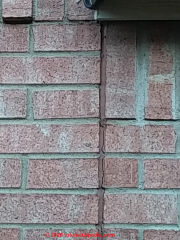 Sam,
Sam,
If we are sure that there are a sufficient number of brick wall control joints or "expansion joints" in your building construction
then I suspect that the expansion joint filler has lost its flexibility.
It would be helpful to know the age of the building and just what material is used in the expansion joint.
Any case the repair may require that the present material is removed and is replaced with a new flexible masonry sealant
See SEAL CRACKS in CONCRETE, HOW TO for some examples of suitable products.
On 2019-08-02 by Sam - crack at brick wall control joint - Dallas TX building
Hi,
I am seeing cracks in the expansion joint (attached photo shown above was taken in Spring), and this crack increases in size (i.e. space between bricks on either side of the joint increases) in summer and reduces in winter.
I live in Dallas, TX. The brick wall faces south west and I suspect the the direct exposure to sun (hot summer) is causing this. Any suggestions on how to mitigate this from happening in summer?
On 2019-04-05 - by (mod) -
Brent the roughly diagonal step cracking pattern, while it could be thermal expansion, probably is NOT in this this case due to heating/cooling.
Take a look at the slight drop in elevation of that last two bricks atop the wall, the fact that the step cracks are much wider near the top of the wall than at the bottom., and the location of the cracking near a corner.
There is also a bit of settlement.
You don't give the country, city location of the wall but the background looks like a hot dry climate like Tucson or Lake Surprise.
Even so there is occasional rain - note the white effloresence on the bricks - or less likely water from an irrigation system (not recommended in AZ).
Settlement can occur even in a dry climate after rain wets and compacts poorly-compacted soil or settles an inadequately prepared footing.
To me this looks like settlement.
On 2019-04-05 by (mod) - Step cracks in Arizona building
Brent the roughly diagonal step cracking pattern, while it could be thermal expansion, probably is NOT in this this case due to heating/cooling.
Take a look at the slight drop in elevation of that last two bricks atop the wall, the fact that the step cracks are much wider near the top of the wall than at the bottom., and the location of the cracking near a corner.
There is also a bit of settlement.
You don't give the country, city location of the wall but the background looks like a hot dry climate like Tucson or Lake Surprise.
Even so there is occasional rain - note the white effloresence on the bricks - or less likely water from an irrigation system (not recommended in AZ).
Settlement can occur even in a dry climate after rain wets and compacts poorly-compacted soil or settles an inadequately prepared footing.
To me this looks like settlement.
On 2019-04-05 by Brent - stair-like separation of the bricks three to five feet from the corner
At the corner or a patio with a brick half-wall that stretches 25 feet long by 4 feet high hitting a right angle where it mates with a the back half-wall of the patio edge (which runs the same length and width), there is a stair-like separation of the bricks three to five feet from the corner, showing starkly on the outside of the brick wall, and easily seen on the inside of the brick wall too.
On the inside, naturally, the bricks are pushing outward an inch at the separation joint.
And, this is Arizona, and the sun beats on that area a good 6-8 hours a day; half of the year 80-100 degrees. So, sure, one might think "Thermal Expansion."
However, complicating a diagnosis is the installation of a fountain at that same corner. So, we wonder if the weight of that fountain added to water erosion from watering the plants might have caused this problem.
I am adding images of the outside and the interior corner. Kind of a puzzler, as we are not sure how to approach this.
That is, we would hate to tear away the corner fountain and corner base, and corner wall all to excavate it unnecessarily.
We would love to just fix the bricks and install an expansion joint if that would do all that is necessary. We had a contractor look at it, but...he wants to rip it all apart. So, again, let us know what you think.
IMAGE LOST by older version of Clark Van Oyen’s Comments Box code - now fixed. Please re-post the image if you can. Sorry. Mod.
On 2019-01-13 by Anonymous
You need an onsite expert, and there could be a collapse risk.
On 2019-01-12 by NR Swain
Sir our home is 2 years old but many cracks found in wall and roof. It sounds a cracking sound every 20 minutes interval. Plz help .. contact no is +917205734043
...
Continue reading at BRICK VENEER WALL LOOSE, BULGED or select a topic from the closely-related articles below, or see the complete ARTICLE INDEX.
Or see BRICK WALL THERMAL EXPANSION CRACK FAQs - thermal cracking brick crack questions and answers posted originally on this page.
Or see these
Recommended Articles
- BRICK FOUNDATIONS & WALLS - home
- BRICK STRUCTURAL WALLS LOOSE, BULGED
- BRICK VENEER WALL DAMAGE ASSESSMENT
- BRICK VENEER WALL LOOSE, BULGED
- BRICK WALL REPAIR METHODS
- BRICK WALL THERMAL EXPANSION CRACKS
- CHIMNEY BRICK / BLOCK SPALLING
- CONCRETE or MASONRY DAMAGE TESTS
- MASONRY FACADE / WALL, LINTEL & BROWNSTONE DAMAGE
- THERMAL EXPANSION of MATERIALS for a table of the coefficient of expansion of common building materials including brick, concrete, mortar, and stone.
Suggested citation for this web page
BRICK WALL THERMAL EXPANSION CRACKS at InspectApedia.com - online encyclopedia of building & environmental inspection, testing, diagnosis, repair, & problem prevention advice.
Or see this
INDEX to RELATED ARTICLES: ARTICLE INDEX to BUILDING STRUCTURES
Or use the SEARCH BOX found below to Ask a Question or Search InspectApedia
Ask a Question or Search InspectApedia
Try the search box just below, or if you prefer, post a question or comment in the Comments box below and we will respond promptly.
Search the InspectApedia website
Note: appearance of your Comment below may be delayed: if your comment contains an image, photograph, web link, or text that looks to the software as if it might be a web link, your posting will appear after it has been approved by a moderator. Apologies for the delay.
Only one image can be added per comment but you can post as many comments, and therefore images, as you like.
You will not receive a notification when a response to your question has been posted.
Please bookmark this page to make it easy for you to check back for our response.
IF above you see "Comment Form is loading comments..." then COMMENT BOX - countable.ca / bawkbox.com IS NOT WORKING.
In any case you are welcome to send an email directly to us at InspectApedia.com at editor@inspectApedia.com
We'll reply to you directly. Please help us help you by noting, in your email, the URL of the InspectApedia page where you wanted to comment.
Citations & References
In addition to any citations in the article above, a full list is available on request.
- In addition to citations & references found in this article, see the research citations given at the end of the related articles found at our suggested
CONTINUE READING or RECOMMENDED ARTICLES.
- Carson, Dunlop & Associates Ltd., 120 Carlton Street Suite 407, Toronto ON M5A 4K2. Tel: (416) 964-9415 1-800-268-7070 Email: info@carsondunlop.com. Alan Carson is a past president of ASHI, the American Society of Home Inspectors.
Thanks to Alan Carson and Bob Dunlop, for permission for InspectAPedia to use text excerpts from The HOME REFERENCE BOOK - the Encyclopedia of Homes and to use illustrations from The ILLUSTRATED HOME .
Carson Dunlop Associates provides extensive home inspection education and report writing material. In gratitude we provide links to tsome Carson Dunlop Associates products and services.


